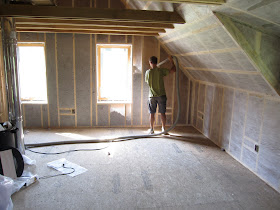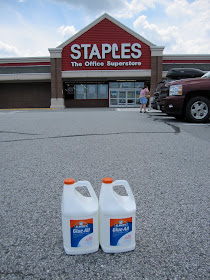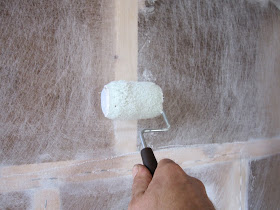Saturday, July 31, 2010
Wrapping up Insulation
Insulating was a lot of work and we finished it up on Thursday. This included insulating the root cellar roof and walls so that the earth temperature is the predominant heating/cooling force in the space. I tracked the temperature in the root cellar over the course of the spring and stopped early in July when it seemed to have leveled off around the high 50's/low 60's. I'll be very interested to watch what happens to the temperature now that the surface earth temperature is mitigated and the deeper-down earth temperature remains unhindered in its exposure.
After a couple of different tries I finally settled on wearing a dust mask, swimming goggles and a cycling cap to ward off the worst of the cellulose insulation blow-back in my face. Just as the cavity being filled nears capacity, there is often a powerful backwards shot of insulation that shoots right back towards the person doing the insulation. Its only manageable if you are well protected.
The last bit of house insulation was doing the spaces around the rim joist under the first floor--basically the band of area that is the first floor/attic ceiling around the perimeter of the house.
At this point the house is finally insulated, but we are going to do a just a little more cellulose blowing-in in a couple of spots, namely the walls of the bathrooms and a few inches under the second floor. This will be done for sound attenuation purposes. We want to minimize the sound transfer between the first and second floor and the bathrooms. Its not too much work and we decided that we'd just do it even though its a little more effort.
Saturday, July 24, 2010
Signs of Domesticity



Nance and I are taking care of two neices and a nephew this weekend and in preparation spent a whirlwind afternoon on Thursday cleaning up, child proofing, and making things comfortable for our first-ever house guests.
Remember that tar paper that we put down to protect the floor of the second floor guest room? No? Well you can see it here when it was first put down; after about nine months we finally pulled it up and the floor looks great.
We also decided to install a rough-and-ready sink so we could do some dishes and whatever other sort of washing we needed to do while the kids were here. The sink is an old farmhouse sink that came out of the old farmhouse that my sister and family live in. Its a great sink and we'd be open to keeping it as our permanant sink but its kinda low between the faucet and drain and there are no dividing bays.
Wednesday, July 21, 2010
Way deep in insulation
 Apparently the newspaper is pulverized before becoming cellulose to the point that you aren't supposed to find individual letters, but Joe found this plus a couple of other semi-discernible bits of type. I love that our house is going to be kept warm by newspapers
Apparently the newspaper is pulverized before becoming cellulose to the point that you aren't supposed to find individual letters, but Joe found this plus a couple of other semi-discernible bits of type. I love that our house is going to be kept warm by newspapersWe've been working really hard on the insulation process. At first it seemed easy, just blowing in tons of cellulose and filling up all the wall and roof space, but then it got much harder when I went back to do the second pass where we bring the cellulose up to the optimal 3.5 lbs. per cubic foot density. This requires reaming the 2" aluminum supply tube into the same nebulous mass again and again and again until you feel like you can't do it any more and then doing it a little more on the chance you missed something.
This is all done at really awkward angles either above your head or at your feet up in the rafters with dust everywhere, an inadequate dust mask over your mouth and a plastic face shield on to keep cellulose from blasting into your eyes when you pull the insertion tube out of the ceiling for the millionth time. Blech! I'm not really for complaining, but this was one job where I just felt like it was an act of will to keep going and do it as well as I could.
The second floor is basically complete, and that was the worst of it. We are in the middle of insulating the first floor and there is much less volume to fill, so its going much quicker, plus its easy to do this work when you just need to stand next to a wall--unlike the complicated mess upstairs! We'll have the first pass on the first floor done tomorrow.
Friday, July 16, 2010
Insulation
 Me, blowing in cellulose on the first pass. In this light you can see the partially filled bays. The hose goes back downstairs to the blower being managed by Joe
Me, blowing in cellulose on the first pass. In this light you can see the partially filled bays. The hose goes back downstairs to the blower being managed by Joe The walls after our second pass to bring the density up to the 3.5lbs per square foot that we are after. Almost looks like a mattress, doesn't it?
The walls after our second pass to bring the density up to the 3.5lbs per square foot that we are after. Almost looks like a mattress, doesn't it? We've spent the last three days insulating the second floor. The process is this:
- Loosely fill each stud bay and rafter bay with insulation a full as possible but not trying to reach finished density
- Once done with step one, go back through and work filling all bays again until finished density is achieved. When you've got it right, the wall feels a lot like a firm mattress.
The way this is done is with two people working on coordination. Joe is on the first floor loading the endless bags of cellulose into the hopper of our blower which then propels the stuff through a long flexible hose that I am managing on the second floor. With me as well is a small switch control that allows me to turn the blower and mixer on and off as needed. Joe has a set of these controls as well.
At the end of the flexible hose is a 4 foot length of pointed aluminum pipe which I use to pierce the insulweb fabric and inject the cellulose. It is almost identical to vacuuming in reverse. It takes hours and hours of work and a lot of thought about what you know is happening in the walls but cannot see once you've started blowing in the cellulose.
Its so great to be doing this work and it is remarkable how it changes the feel of the interior. It is now quiet in a way that is sort of like "being in a cotton ball" as someone described it. It feels really good. Its also neat to be doing work that is pivotal to the whole process in terms of making good on our energy performance goals.
Tuesday, July 13, 2010
Insulweb instal
 I had to go to an office supply store to find gallon quantities of Elmer's Glue, our current means of attaching the Insulweb to the framing
I had to go to an office supply store to find gallon quantities of Elmer's Glue, our current means of attaching the Insulweb to the framingWe are continuing to put up the Insulweb retaining fabric and its going just fine. The second floor is the more complex part of the house to do and we have just a little more work to do there tomorrow morning and then we'll start actually blowing in the cellulose insulation. For those who may be unfamiliar with cellulose, it pulverized newsprint that has been treated with a borate for fire retardancy, mold and pest control and just small amount of mineral oil to help keep dust down.
Sunday, July 11, 2010
Super-Insulation class visit

This morning the Super-Insulation for Zero Energy Building class from Yestermorrow came to take a tour of the house. I took this class a year and a half ago and it was pivotal in solidifying the direction we wanted to go in designing our house; there is greater up-front investment in a super-insulated home, but the payback is rapid and the long term savings are remarkable. The information in the class made that unmistakeably clear. There are multiple benefits beyond just the financial, but suffice to say that I credit the class with convincing me that it would have been almost irresponsible to do anything less then we were able in making our house as energy efficient as possible.
I gave a brief overview of the features of the house; stack framing, the double-wall construction, air sealing efforts, the boiler, the HRV (Heat Recovery Ventilation) unit, the root cellar, and the overall effort to reach high R-values throughout. There were a bunch of questions and it was a good give-and-take.
Its great to be able to share what we are doing in a useful way.
Goodbye framing
We are beginning the insulating process.
On Friday I put up the first large areas of Insulweb, which is a retaining fabric that will be attached everywhere that we'll be insulating--along the exterior walls and second floor ceilings.
The key is to get the fabric quite taught, so I stapled it up neatly at each corner and then carefully worked it along the whole perimeter. Once the fabric is hung, I come back with a roller and an adhesive glue that I then roll along all the framing members under the fabric. This fixes the fabric wherever it comes in contact with the wood. As soon as we've got the fabric up throughout the whole house, we'll start blowing the cellulose insulation into all the wall and roof areas through small slits in the fabric.
Its such a relief to finally be moving onto this work after a long haul leading up to this point. I expect this work to go relatively quickly and then we'll be on to sheetrocking.
Wednesday, July 7, 2010
A few last pieces in place
Working in temps up around 100 the last couple of days we are finally ready to begin the insulation. The insulation is all here and loaded into the house; we did the blower door test and were able to get a benchmark for air infiltration into the house; the last couple of in-wall details are complete and we really are ready to start putting up the retaining fabric tomorrow. I'm really excited to finally be getting off the ground with this phase of the work.
Sunday, July 4, 2010
Preping for for solar hot water
 There is now a second pipe through the left-side roof close to the ridge allowing for the solar lines to connect to the panel which will be mounted on the other side of the roof (the sunny side)
There is now a second pipe through the left-side roof close to the ridge allowing for the solar lines to connect to the panel which will be mounted on the other side of the roof (the sunny side)Its come a little late in the process but we have determined that we can and will be installing a solar hot water panel on the roof.
In order to be prepared for this we needed to put another hole through the roof to allow passage of the supply and return copper lines to go from inside the house out to the panel mounted on the roof.
The lines pass down from the roof through the walls of the 2nd and 1st walls to the basement where we'll eventually connect them to a hot water storage tank.
We're ready
 We cleared everything out in order to store the insulation shown in the top photo inside the house once its delivered
We cleared everything out in order to store the insulation shown in the top photo inside the house once its deliveredAfter what seems like such a long time we are finally ready to insulate.
On Tuesday morning, Bill Hulstrunk is going to come and perform a blower door test on the house to check for air leaks. From what I've read, air leakage can cause anywhere from 30 percent to 50 percent of the heat loss in some homes.
The blower door test is a proceedure where you negativly pressurize the house and measures the rate of airflow required to maintain the building at a certain pressure. We'll be able to quantify the area of leakage. Vent ducts and other intentional openings are all closed so the house is otherwise sealed.
Typically a blower door test is done after insulating has occurred, but I want to know what leaks are present before we insulate while we can still get at them. Whatever the result, the cellulose insulation will be working for us as an air barrier in the walls, so its a sure thing that our numbers will go up. I would expect most leakage would be around the windows and doors, so we'll be checking for that.
Joe finished up the baffles in the long roof rafter bays and I spent the better part of Friday sealing every imaginable air passage around the windows and doors. I've been half-joking with folks that I'll pay $10 bucks to anyone who can find a hole anywhere in the house.
The first batch of insulation will delivered tomorrow.























